The Clarkdale Review: Intel's Core i5 661, i3 540 & i3 530
by Anand Lal Shimpi on January 4, 2010 12:00 AM EST- Posted in
- CPUs
Ridiculously Fun to Overclock
We’ll start off with the obligatory maximum stock VID overclock of a 661 ES Clarkdale using Intel’s retail cooler:
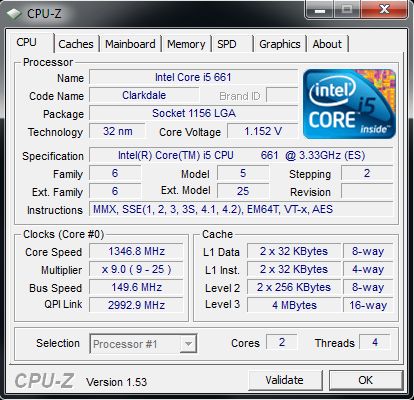
Maximum overclock @ stock voltages (3874MHz)
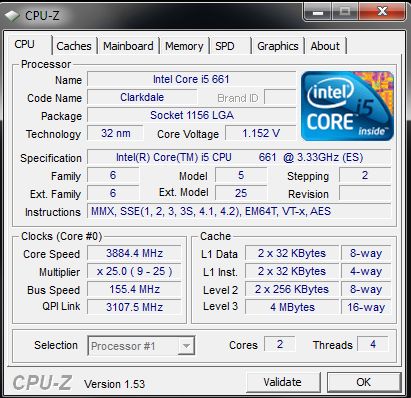
Maximum overclock @ stock voltages without Turbo
With increased core VID, speeds up to 4.3GHz are possible on the stock cooler:
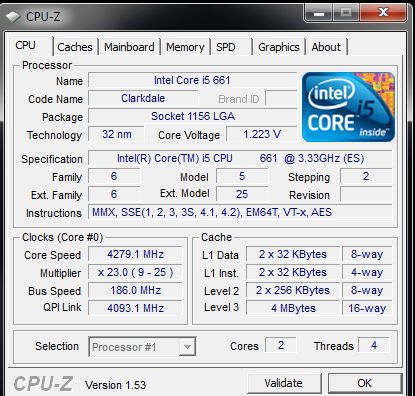
A 0.1V boost puts you in the 4.3GHz ballpark.
Watercooling
Clock for clock performance of Clarkdale against other platforms may not be impressive, but frequency scaling with good cooling is:

4853 MHz stable comes in with a processor load voltage of around 1.438V. Memory performance is related directly to the QPI link ratio. For best performance, keep the QPI link speed as close as possible to CPU core speed to minimize buffer hold times for lower memory access latency.
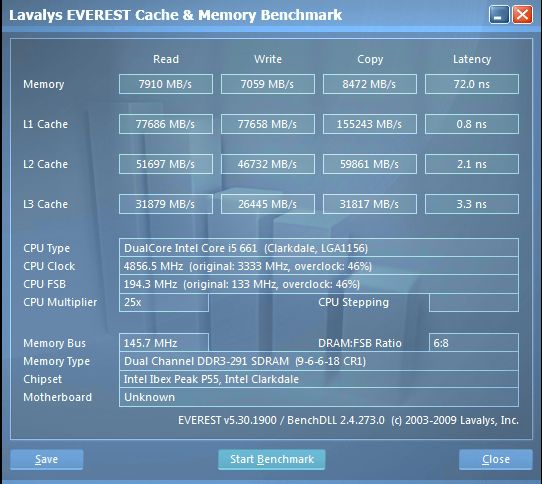
12X QPI Multiplier
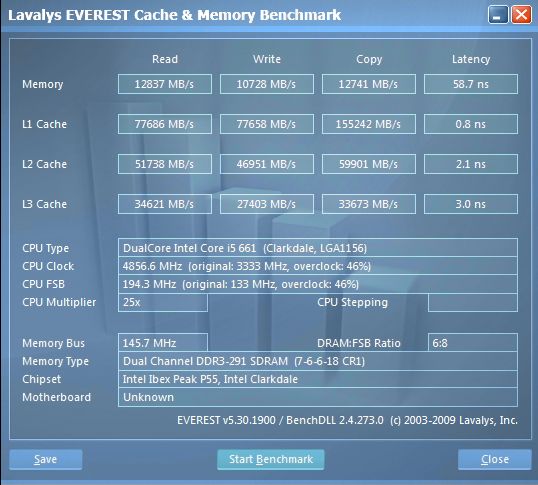
24X QPI Multi
The bandwidth figures are not stellar on either side of the scale (bear in mind the Everest bench DLL needs an update for Clarkdale). However, the higher QPI multiplier ratio is essentially free for the taking; requiring no additional IMC (VTT) voltage increase until BCLK is increased past 210 or so.
Like Lynnfield and Bloomfield, odd CPU multiplier ratios are more stable than even, although the disparity is less pronounced on Clarkdale. We found that even multipliers needed higher VCore at the same overall processor frequency or needed to be run at a lower overall overclock for stability. We’re not sure on the exact cause of this issue but it’s likely to be related to frequency synthesis within the CPU and downstream logic sampling.
Another caveat with Clarkdale overclocking is that the platform seems to be limited to memory speeds below 1600MHz as soon as you increase BCLK significantly (speeds over 1600Mhz are possible at stock BCLK). We’d hedge bets this is due to the memory controller relying on a preset DRAM clock skew table like Intel’s Front Side Bus architectures of old. The current DRAM frequency ceiling means that you’ll be shooting for CAS 5/6 capable memory between 1300-1600MHz for best performance with 4GB of RAM. 8GB configurations require a loose set of sub-timings, and also a 2N Command Rate to achieve 1600 MHz stable on our sample processor.
Sub-Zero
Bloomfield was hit and miss when it came to frequency scaling at low temperatures. Clarkdale seems to be a different animal altogether:
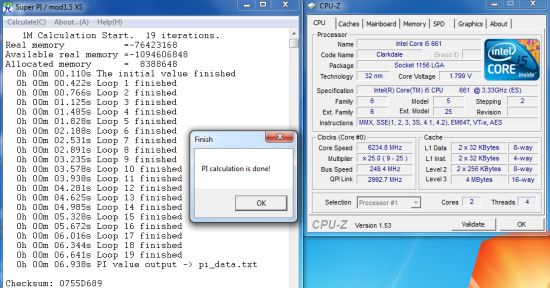
This is what ‘Clarkie’ is good at..
This screenshot was taken with our cascade cooling the CPU. Evaporator head temperatures were in the region of -115 Celsius. Most Lynnfield/Bloomfield CPUs were out of their comfort zone at these temperatures, but Clarkdale seems to be at home. You still get the occasional cold boot bug, but most of the ES CPUs will run benchmarks right down to the boiling point of LN2 (motherboard permitting). We’ve seen screenshots of 3D benchmarking above 6.5GHz and Super Pi runs edging close to 7GHz. Sounds great, but unfortunately, Super Pi 1M is the only benchmark where Clarkdale is really competitive. Once you’re past 230 BCLK, you have to leave QPI frequency on the floor which hurts memory performance in a big way. Couple that with the 1600MHz or so cap on DRAM frequency and you’ll understand why Super Pi 32m doesn’t fare so well on this platform. 3D performance in Futuremark’s 3DMark05 is just about competitive with the current ‘top’ Bloomfield results if you can run Clarkdale at 6.5GHz throughout the bench. The upshot is that we think there will be more good Clarkdale chips capable of 6.5GHz than there are Bloomfield CPUs that can run 3D benchmarks at 5.4GHz. The funny thing is that P55 motherboards using an NF200 to provide triple CrossFire/SLI might actually be the way to go for benchmarks like 3D Mark 05 if you’re into competitive benchmarking!
While Clarkdale may not be the fastest performer from Intel, it’s probably the most fun to overclock.










93 Comments
View All Comments
Paladin1211 - Monday, January 4, 2010 - link
On page 13, in WoW benchmark, the Core i5 750 outperforms the Core i7 870 by more than 30% (92.3 fps vs 70.6 fps). Anything wrong here?Crimson67 - Tuesday, January 5, 2010 - link
WoW doesn't seem to like hyperthreading, it's the only explanationereavis - Wednesday, January 6, 2010 - link
is it using the hyperthread core on the 870 but a true core on the 750? That would certainly slow it down. If it's using a true core on both it should be better still.Dyzios - Monday, January 4, 2010 - link
Remember NVIDIA Hybrid idea, to have two GPUs ? - one weak for 2D/light 3D graphics and powerful discrete GPU for gaming? Those CPU makes sense for this approach - however Radeon 5870 also has good point with optimized low idle power consumption. Maybe still there is point as even Radeon cannot go very low as GPU on-die. The only question is to have capability to switch HDMI output between on-die GPU and discrete.I wonder how this works currently - still needed to stick to DVI output from Radeon or can be combined?Zool - Tuesday, January 5, 2010 - link
If the 40nm 5600 series cards will show the same improvments in power usage than the 5800 series than u can forget the intels GMA graphic.I think that for a 2D card/3D discret card u can buy a mobo with a dirty cheap intel GMA on it clocked much lower if u realy need.
silverblue - Wednesday, January 6, 2010 - link
The graphics comparison isn't exactly fair but in the end, it's not something AMD should be too worried about. The i5-661, with its 900MHz 45nm GPU, is being compared to the old 790GX's HD 3300 which operates at 700MHz on a 55nm process. I admit, in the benchmarks we're talking the best i5 vs. the best AMD has to offer, but considering...a) the relative performance of the i5-750 as compared to the PII X4 965 which is usually manifested as an advantage
b) the fact that the 32nm i5s can increase their core speed by 133MHz and 266MHz thanks to Turbo depending on the number of active cores
c) most games still aren't designed to take full advantage of multithreading so four cores may not yield a tangible performance increase
...then AMD's still in the lead for IGPs. If the 3300 had been clocked at 900MHz, would it have lost even one of the listed benchmarks? I'm not sure it would have. What's more, we're still talking a 55nm part; we all know of TSMC's issues with the 40nm process and AMD going fablress, so is it unreasonable to expect that AMD could move their IGP production en masse to 40nm with TSMC or 45nm with GlobalFoundries?
In closing, it's a big step forward for Intel, however if AMD came out with a higher clocked 40/45nm IGP then, Sideport or not, new tech or not, AMD would be far ahead, at least on gaming terms. Sideport does very little for the performance of current AMD IGPs, anyway.
I just wish AMD were able to release a Clarkdale competitor sooner rather than later.
ruetheday - Friday, January 8, 2010 - link
the IGP on Clarkdale isn't maxed out at 900Mhz; It too can be overclocked significantly. Here's an article on techgage showing an OC to 1133, for example.Remember that Intel is very conservative on binning parts to ensure no issues with reliability over time (compare vs nvidia mobile gpus).
silverblue - Friday, January 8, 2010 - link
Maybe so, however a 40/45nm AMD part could reach similar clockspeeds. I just don't think that, clock for clock, the new Intel IGP on the Clarkdale die is as powerful as anything AMD or nVidia can produce on the same scale. It's a good step forwards, just not the leadership that some may have been expecting.silverblue - Wednesday, January 6, 2010 - link
Slight mistake... second best 32nm i5 that Intel has to offer. However, I doubt the performance increase over the 661 will be very noticable with the IGP; won't it be clocked the same in both?Zool - Monday, January 4, 2010 - link
The irony is the biggest drawback of these cpu-s is the 45nm intel graphic on other die with the memmory controler. The die savings from 45nm vs 32nm are quite big.If they would make just 32nm dual core nehalem with memory controler on die it would be still much smaller(and only litle bigger than the clarkdale without imc) than the GMA die with memmory controler.
The whole thing would be solved with everything as one on 32nm.
I think plenty of people just wait for 32nm quad core nehalems without the useless GMA graphic.
Actualy what is the cost of dirty cheap GMA in penryn based 3 package boards. Like 5-10 dolars ?